
New York City Independent Budget Office
Eliminating New York City’s Utility Excise Tax: Economic and Fiscal Impacts Eliminating the UXT: Economic and Fiscal Impacts

Eliminating New York City’s Utility Excise Tax: Economic and Fiscal Impacts Eliminating the UXT: Economic and Fiscal Impacts
New York City residents, businesses, and institutions pay about $220 million each year for a tax levied by the city government on energy and telephone utilities. The tax, known as the utility excise tax or UXT, is passed along to consumers by utilities in the form of higher monthly bills. At the request of Public Advocate Mark Green, the Independent Budget Office has prepared this fiscal brief to assess the economic and fiscal impacts of eliminating the UXT. Our principal findings include:
April 1999 |
Introduction
Electric, gas, steam, and local phone services in New York City are subject to the city’s 2.35 percent utility excise tax (UXT). While large utility companies formally pay almost all of the $220 million tax on energy and telecommunications, they do not ultimately bear its cost. The tax is folded into the rates and charges on customer utility bills and adds to the cost of living and doing business in New York City.1
Indeed, the city UXT is just one of a plethora of state and local taxes built into utility bills in New York City. Altogether, these taxes account for almost 20 cents out of every dollar spent on energy and phone services in the city. The heavy utility tax burden contributes significantly to the city’s unfortunate distinction of having the second-highest business energy costs—and highest overall business costs—in the nation (see Figure 1).
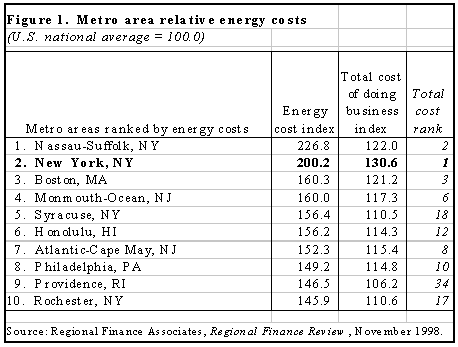
This fiscal brief begins with a review of how energy and phone utilities are taxed in New York City. The second section details how the utility tax burden is distributed among residential households. The next section examines the effect of eliminating the city UXT on energy and phone costs and traces the overall impact on utility taxation. This is followed by an analysis of the long run primary and secondary impacts of eliminating the UXT on the city economy and city government budget. Prior to concluding, a brief section then considers the argument for eliminating the UXT in the context of utility deregulation. The sources and methodology used in the study are discussed in a technical appendix.
Utility taxation in New York City
Utility receipts in New York City are subject to seven different state and local excise or product taxes. Besides the 2.35 percent city utility excise tax (UXT), the cost of utility services in New York City also includes a 3.25 percent (2.5 percent as of January 1, 2000) state gross receipts tax (GRT) and a 0.75 percent state franchise tax, both of which are augmented by a Metropolitan Transit Authority (MTA) surcharge.2 These rates apply to almost all utility company gross revenues, although (as discussed below) lower state gross receipts tax and surcharge rates are imposed on Con Ed service delivery charges billed to the New York Power Authority (NYPA).
In addition, most utility sales are subject to a 4 percent state sales tax, a 4 percent city sales tax, and a 0.25 percent MTA sales tax surcharge. Residential consumption of gas and electricity is exempt from the state sales tax and MTA sales tax surcharge, and sales of utility services to government and non-profit entities are exempt from all sales taxes.
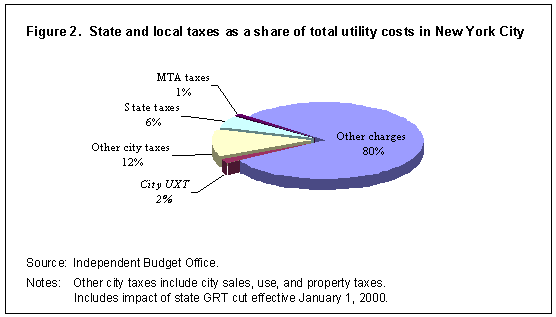
All of the taxes listed above are imposed on utility outputs and calculated as percentages of the value of services sold to consumers.3 Such taxes are passed forward to consumers in higher gross prices (particularly in cases where, as in the utility industry, there are relatively few suppliers). We will show below how these taxes affect utility rates and charges.
New York City utility costs also incorporate various state and local taxes on inputs used in the production and transmission of energy and phone services. These taxes include use taxes and surcharges on utility company purchases, state petroleum business taxes, and local property (including special franchise) taxes.4 Typically these kinds of taxes are only partly reflected in prices paid by consumers, but the regulatory statutes and agreements under which utility rates are set have effectively shifted the burden of these taxes to energy and phone users as well.5
Altogether, state and local taxes levied on the utility industry in New York City are expected to generate (even after the reduction in the state GRT nominal rate from 3.25 percent to 2.50 percent) about $2.1 billion in 2000, one-fifth of the $10.3 billion in energy and local phone utility costs borne by consumers.6 The tax share of total energy and local phone costs is pictured in Figure 2, and the distribution of tax revenues by level of government, type of tax, and consumer of energy and phone services is detailed in Figure 3.
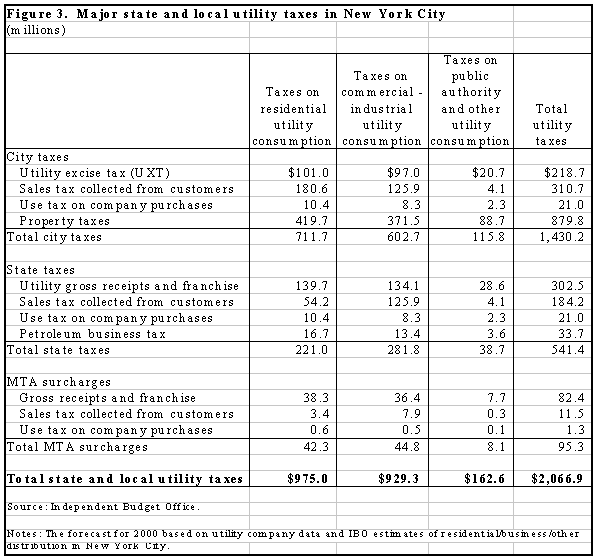
Distribution of Utility Tax Burdens
Since consumers finally bear utility taxes, assessing the impact of eliminating the city UXT requires knowing how the utility tax burden is distributed among consumers—between businesses and households, between rich and poor, between owners and renters, and between different parts of the city. To do this, we need to know first of all how overall utility spending itself is distributed, and a good portion of this analysis has been devoted to the task of putting together and adjusting utility expenditure and consumer characteristics data from various sources. This was followed by further adjustments to reflect the differing tax shares of overall utility spending in different consumer categories.7
New York City residents will pay $101 million in city utility excise taxes in 2000, an average of $37 per household.8 The residential UXT total includes an estimated $15 million paid by households in poverty. Total residential taxes are divided almost equally between owners and renters, but, as Figure 4 (panel B) shows, average owner tax burdens are over twice as high as average renter burdens.
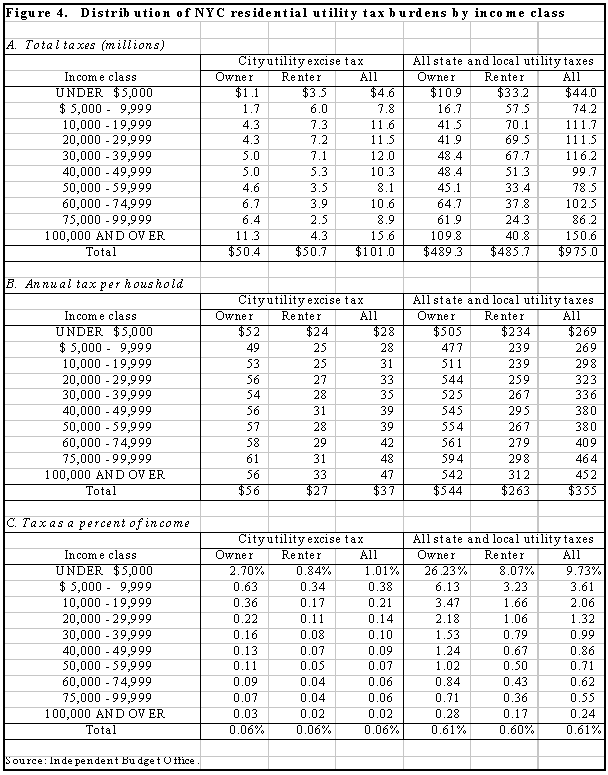
There are three reasons why average renter utility tax burdens are lower. First, a higher proportion of renters lives in large apartment buildings, which are relatively energy efficient. Indeed, the $45 annual average household UXT bill for gas and electricity in one-, two-, and three-family homes (property tax class 1) is almost three times as large as the $18 annual average household UXT bill for energy use in buildings with four or more units (property tax class 2)9.
Second, renters tend to live in smaller units and therefore use less energy per household than do owners in both class 1 and class 2 housing.
Third, a surprisingly large number of renters do not own phones and therefore do not pay phone utility taxes. According to the 1990 Census, only 81 percent of renters with incomes under $10,000 and 90 percent of renters overall owned telephones in New York City, as against 97 percent of homeowners with incomes under $10,000 and 99 percent of homeowners overall.
Nevertheless, the city UXT is regressive throughout the entire household income range, with the UXT burden as a share of income ranging from 1.0 percent for households with incomes less than $5,000 down to just 0.02 percent for households with incomes of $100,000 or more. This reflects the fact that as household income rises, spending on utilities does not rise proportionately.
All of these findings concerning the distribution and incidence of residential city UXT burdens also hold for total utility tax burdens—except, of course, that the numbers are much larger. The $975 million in total residential utility taxes forecast for 2000—inclusive of all excise and sales, property, and company use taxes incorporated in residential utility bills—works out to an average annual burden of about $355 per household. The details are exhibited in the right-hand columns of Figure 4.
The distribution of residential utility tax burdens by borough is shown in Figure 5. Brooklyn and Queens alone account for nearly 60 percent of the total residential utility tax burden, not only because of their large populations, but also because of their even larger shares of the city’s high energy-consuming class 1 housing stock.10 The highest average household utility tax burdens are in Staten Island, but the heaviest burdens relative to income are in the Bronx.
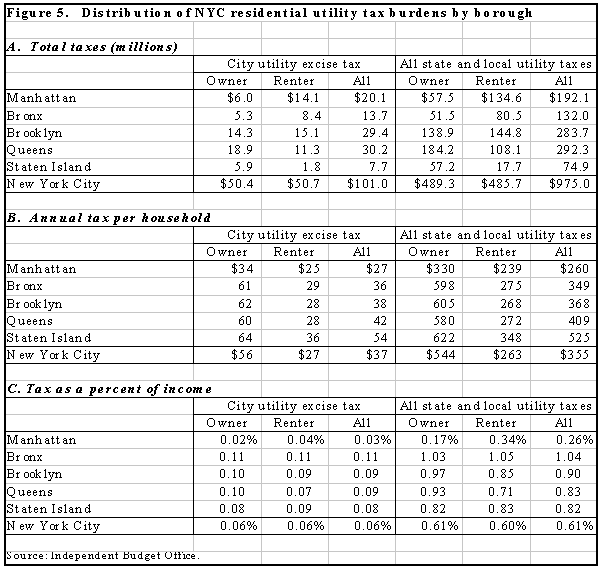
The average tax as a share of income in Manhattan, in contrast, is only one-third of that in the rest of the city. Again, this reflects Manhattan’s high concentration of apartment dwellers, as well as the borough’s relatively high overall average household income.
In addition to the residential burdens discussed above, New York City’s 200,000 private businesses will pay $97 million in city utility excise taxes and $930 million in total utility taxes in 2000. Thus the average business will carry a $489 city UXT burden and pay almost $4,700 per year in total state and local utility taxes.
Eliminating the UXT: Utility Cost Impacts
If New York City eliminated its utility excise tax, it would affect both the overall cost of utility services in the city and the other state and local product tax revenues derived from utility use in the city. These impacts are examined in this section. Over time, the change in utility costs would be accompanied by a series of business, household, and government adjustments—which in turn would have fiscal consequences for the city beyond the direct loss of UXT revenues. We estimate and analyze these secondary tax cut impacts in the next section.
Because of the way utility tax rates are calculated and applied, eliminating the city’s utility excise tax actually includes reductions in other utility excise tax revenues as well. This is because the city UXT is actually part of the base of the other taxes. The consequences of this are illustrated in Figure 6, which shows the amount of state, MTA, and total excise taxes typically collected on a "basic" (pre-product tax) service charge of $100 with and without a city UXT.
Here we can see that in 2000 the state will collect $3.44 in gross receipts and franchise taxes on a $100 basic charge when there is a city UXT, but only $3.36 when the city UXT is removed. This is because when the city UXT is present, the state’s 3.25 percent nominal GRT/franchise tax rate will be applied to a base of $105.93, while when the city UXT is removed, the base is only $103.36. In the first case, the base to which the nominal rate is applied includes a mark-up for the city UXT—and for the state product taxes themselves as well. In the latter case, the mark-up is smaller, because only the state excise taxes are added into the base. Without the city UXT, the bases for all the other utility output taxes (MTA excise surcharge, city, state, and MTA sales taxes) are likewise reduced.
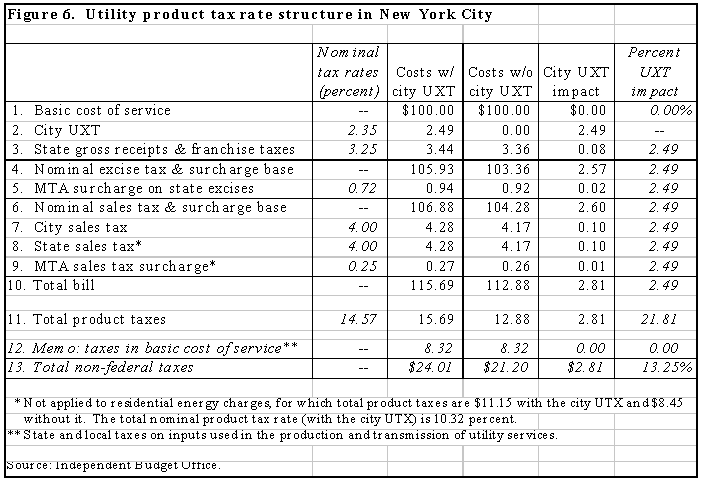
Figure 6 also shows that the nominal excise tax rates itemized earlier are not the same as the effective rates—that is, the percentage increases in pre-tax costs produced by the taxes. Thus while the nominal product tax rates in New York City sum to 14.57 percent, these taxes combine to boost private energy and phone costs by 15.69 percent.11 This is the total effective product tax rate on business energy and phone service consumption and on household local phone consumption.12 (Because residential energy is exempt from the state sales tax and surcharge, here the total nominal product tax rate is 10.32 percent and the aggregate product tax-driven cost increase, the effective rate, is 11.15 percent). When the city UXT is present, the effective rates of all the other excise taxes increase by 2.49 percent—that is to say, by the amount of the UXT effective rate.
Because the city utility tax is part of the base for the other taxes imposed on final utility sales in New York City, eliminating the tax would also yield savings in other utility product taxes borne by consumers. The total utility tax impact is shown in Figure 7.
Figure 7 shows that when the $219 million energy and phone UXT is eliminated, the removal of this amount from the base of the other utility product taxes would lower overall utility tax collections—and overall phone and energy consumer costs—by an additional $21 million. The total reductions listed in Figure 7 would translate into average savings of $30 per year for renters, over $60 per year for homeowners, and $540 per year for businesses in New York City.
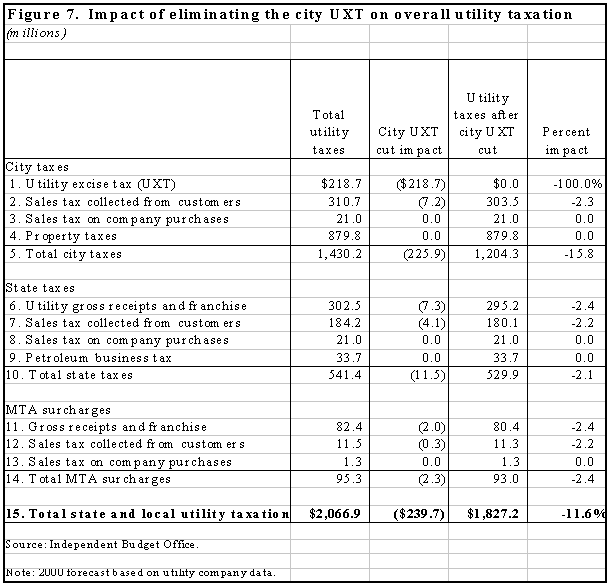
Since one of the other taxes on utilities that would be affected by a city UTX cut is the city sales tax (Figure 7, line 2), the total reduction in city utility tax revenues (Figure 7, line 5) would be slightly larger than just the UXT revenue loss (Figure 7, line 1). Moreover, since MTA surcharges fund the parent of New York City Transit, which is one of the city’s covered organizations and also receives city funding, the utility surcharge reductions (Figure 7, line 14) could be construed as an additional negative fiscal impact for the city.
Eliminating the UXT: Overall Economic and Fiscal Impacts
The overall city fiscal impact of eliminating the UXT on energy and phone services is shown in Figure 8. The first line is simply the direct UXT revenue loss.13 The additional utility tax losses shown on the second line (Taxes on city UXT) corresponds to lines 2 and 14 in Figure 7 as discussed in the previous paragraph.
A city UXT cut would also have two important positive fiscal consequences for the city. First, it would immediately reduce the city’s own utility costs. Second, over the longer run, it would spur growth in the city economy, leading to increases in other city tax revenues.
Government utility costs. New York City government, including its covered agencies, spends upwards of $500 million per year on heat, light, power, and phone services. A surprisingly large share of this total consists of services subject to the city’s own utility tax. The tax is not added to final sales by the New York Power Authority (NYPA), which provides the bulk of the electricity consumed by the city and its covered agencies. But much of the cost of the electricity provided by NYPA consists of delivery or "wheeling" charges paid to Con Ed for transmission of the electricity. Wheeling charges passed on by NYPA to the city and its covered agencies were $117 million in 1998. State gross receipts tax and surcharge rates are reduced on these charges, but city UXT rates are not.14 The full city UXT rate is also charged on direct sales of utility services (steam, gas, and phone) to city government.15
The impact of UXT elimination on the city expense budget is shown on line 3 of Figure 8. IBO estimates that eliminating the city’s UXT would lower utility expenses by the city and its covered organizations by approximately $12 million. (This includes an estimated $500,000 in savings on the state UXT and MTA surcharge, due to the removal of the city UXT from their base.) It is especially worth noting that the above includes an estimated $3 million utility expense saving by New York City Transit; this alone would more than compensate the MTA for its estimated $2.2 million surcharge revenue loss in 2000.
Economic growth. Eliminating the city utility excise tax would lower the typical business utility tax burden from $4,700 to $4,150—still relatively high, but a substantial improvement. New York City’s energy cost index (see Figure 1) would fall from 200.2 to 195.5, lowering the overall cost-of-business index from 130.6 to 129.9.16 The city would still have the second highest relative utility costs and highest overall business costs of all US metropolitan areas, but our cost structure would become more competitive, and this should have a positive long-term impact on city economic growth.
Using a regression model developed to measure the relationship of business cost differentials to metropolitan area growth rates, Regional Finance Associates (RFA) estimates that the reduction in energy costs associated with eliminating the city UXT would increase the city’s employment growth rate by 0.2 percentage points over the ten year period following the tax cut. This works out to about 7,000 new jobs in the city economy.17
This increase in city jobs and output would, in turn, boost collections of other city taxes. The estimated secondary tax impact is shown on line 4 of Figure 8. The full tax revenue impact would be considerably lagged because (by design) billable property values and collections only gradually accommodate changes in economic conditions. When all secondary tax impacts are fully phased in, IBO projects that they could offset over one-quarter of the gross UXT revenue loss.18
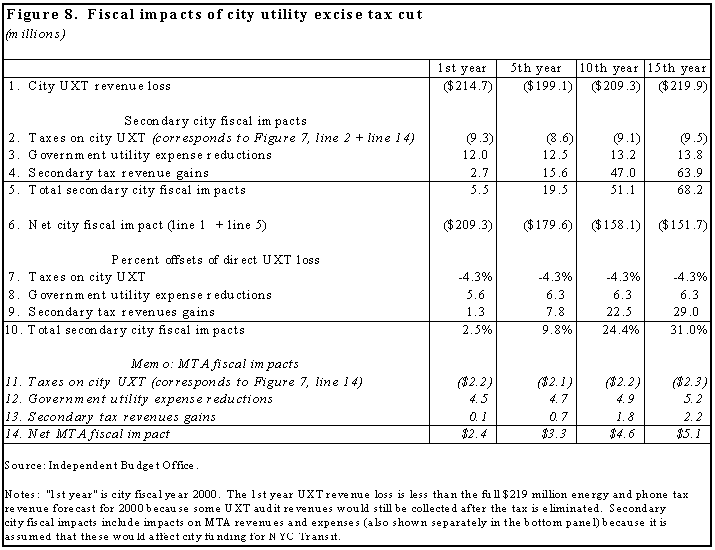
Altogether, reduced government utility costs and induced growth in other city tax revenues could in the long run offset close to one-third of the city utility excise tax revenues lost eliminating the tax.19
Finally, it should be noted that the stronger growth in the city economy would also boost state non-utility tax revenues and increase MTA revenues from its various non-utility tax surcharges. The fiscal impacts on the MTA are included in the overall city impact numbers in Figure 8 (and are also broken out separately at the bottom of the table), because both the MTA and the city provide funding for New York City Transit, and the city would probably have to assume fiscal responsibility for the effects of its tax policy on the MTA.
Deregulation and Utility Taxation
Deregulation and the introduction of competition are currently bringing profound changes to the utility industry both in New York and nationwide.20 But while deregulation is beginning to slowly lower utility costs in New York City, it is having or will have similar (if not greater) impacts on costs in other parts of the country, thus doing little to reduce the city’s marked competitive disadvantages in this area.21 Easing the exceptionally large tax load imposed on businesses and households through utility taxation, on the other hand, would immediately make the city a more attractive place to invest and live, in both absolute and relative terms.
This does not mean that utility tax relief should be conceived as a substitute for fostering competitiveness in the provision of local phone and energy services, for failure to keep pace in deregulation would progressively undo the gains secured by tax reduction. It appears then that both deregulation and utility tax reduction would be required in any effort to ameliorate utility cost disadvantages in New York City.
Deregulation also has a bearing on the question of whether the city should subject utilities to a business net income tax if the UXT is eliminated. Within a regulated rate structure, substituting an input tax for a product tax would not change much for utility consumers: the burden of a business income tax would be nearly as heavy as that of the UXT, and it would be passed onto consumers (as is the case with the UXT).
With increased competition in the utility industry, it will become harder for utilities to raise prices to pass the cost of input taxes to consumers. At the same time, however, it will also become harder for utility companies paying higher than average input taxes to hold market shares against rivals that are not so burdened. Under the allocation formulas used in calculating the income and capital subject to the city’s general corporation tax, a utility with service production facilities and workers based in New York City would be taxed more heavily than a utility producing services elsewhere for sale in the city. Indeed, local utilities are already competitively disadvantaged by the city’s relatively heavy property taxes.22 A city tax on utility net income would only increase the local provider disadvantage, and would likely lead to a loss of utility industry jobs in the city.
Conclusion
This study has found that utility taxation has a substantial impact on local phone and energy costs in New York City, with the product and input taxes levied by the city, state, and MTA adding over $2 billion to the already high cost of utility services in the city. It is the consumers of utility services who end up bearing these taxes. The taxes are inefficient because in pushing up utility costs they drive investment away from the city. They are inequitable because they disproportionately burden lower income households.
IBO has found that the net city budgetary cost of eliminating the UXT would be substantially smaller than the $215 million in UXT revenue losses. There would be two major positive offsets to this revenue loss. First, because the UXT is charged on the government’s own energy and local phone use, eliminating the tax would immediately lower the utility expenses of the city and its covered organizations by $12 million.
Second, by lowering utility costs for businesses, the UXT elimination would strengthen economic growth in New York City, potentially adding up to 7,000 jobs to the city economy over the ten years following elimination. The added output and income accompanying these new jobs would generate additional revenues from other city taxes. Eventually these secondary city tax increases could offset more than one-quarter of the city’s UXT revenue loss. Altogether, reduced government expenses and increased secondary revenue collections could lower the net cost of eliminating the UXT by as much as one-third.
Appendix: Methodology and Sources
Property taxes.
Regulation provides for periodic adjustment of Con Ed charges to reflect changes in property taxes. A change in any property tax levied on Con Ed property in New York City, Westchester, or upstate New York will affect its charges to all customers. Thus it is Con Ed’s total property tax payments multiplied by the city consumer share of total company revenues—and not simply the company’s New York City property tax payments—that go into the energy bills paid in the city.A rate freeze has prevented Bell Atlantic (formerly New York Telephone) from passing city or other local property tax changes through to customers since 1994. However, Bell’s property tax burden in 2000 will be roughly the same as it was when rates were frozen (recent and projected increases are just offsetting the drops that occurred during the recession in the early 1990s). It can be assumed that Bell customers will bear (at least) the equivalent of actual city property taxes paid in 2000 in their local phone bills.
It should be noted that in the absence of both regulation and "normal" competition, profit-maximizing utilities would have been in a position to charge more (and profit more) than they currently do from utility service sales, but a smaller absolute portion of the total charge would have reflected utility factor taxes (such as property taxes), and any increases in such taxes would have reduced above-normal profits rather than further increased above-normal charges.
It can be expected that as deregulation and competition comes to the utility industry in New York, the incidence of utility property taxes will come to resemble more what economists believe normal (competitive) property tax incidence is: the taxes on improvements will be borne generally by the owners of capital, with local tax differentials raising the cost of utility services where taxes are relatively high and lowering costs where taxes are relatively low. But in relatively high property tax areas (like New York City), the utility product prices faced by consumers would be raised by an amount proportionate to the utility property tax differential, not (as appears to be the case at present) by the entire utility property tax.
Distribution. IBO’s estimate of the distribution of residential energy tax burdens is based on Housing and Vacancy Survey (HVS) data on household gas and electricity spending, with adjustments to account for utility expenses included in rents (including common space energy expenses in apartment buildings). The spending and income data in the survey have been trended up from 1995 to 2000.
To estimate the distribution of residential phone tax burdens, we used survey data on household phone spending collected by PRN and Associates. After trending up from 1997 to 2000, PRN’s spending-per-household data was averaged over all city households using rates of phone ownership in New York City as recorded in Public Use Micro Sample (PUMS) data for the 1990 Census. In estimating the tax shares of total phone bills, further adjustments were made to reflect the exclusion of some local phone provider charges from the city UXT base (calls must both originate and terminate in the city to be subject to the city tax).
HVS data on household incomes (adjusted to compensate for underreporting in the top income bracket) was used in calculating utility tax burdens as a percentage of income.
The household incidence estimates supplied here do not include the utility taxes imposed on businesses that resident households ultimately bear either as owners of these businesses or as consumers of their products. All business taxes are one way or another ultimately borne by households, but not all utility taxes passed on to New York City businesses are ultimately borne by city resident households, since some of the owners and customers of city businesses are non-residents. (Conversely, city residents also bear non-local utility taxes as owners and customers of businesses located outside New York City. These tax burdens are also not included in the city resident household utility tax burden total.)
Job growth. When RFA estimated the boost to New York City employment growth from reducing the city’s energy cost index from 200.2 to 195.5, they did not take into account the fact that in the case of eliminating the city UXT, the drop in utility costs would be accompanied by a loss of government revenues, resulting in a reduction in publicly funded employment. (Note that like any change in employment in a particular sector, this would also have secondary impacts on employment in other sectors of the economy.)
On the other hand, the RFA estimate did not explicitly account for the fact that cost reductions from the UXT elimination would also extend to telecommunications services, thus possibly leading to a larger impact on RFA’s total cost-of-business index than is normally provided by a change in the energy cost index. IBO assumes that these two offsetting impacts would roughly cancel each other out.
| 1 | Although this study focuses exclusively on energy and phone taxes, the 2.35 percent UXT is also levied on venders of water and refrigeration services. In addition, the UXT is imposed at a 1.17 percent rate on operations of limited fare omnibuses and at a 3.52 percent rate on the operation or lease of sleeping and parlor railroad cars. Together these taxes generate an estimated $20-$25 million. |
| 2 | The MTA surcharge is calculated as 17 percent of what the GRT would be if its rate had not been reduced from 3.5 percent (the rate in effect prior to October 1, 1998). Consequently, the surcharge is effectively more than 17 percent of the current GRT, and will be close to 30 percent of the GRT in 2000. |
| 3 | For more detail on utility product taxes, see Orrin Tilevitz, "New York's Taxes on Natural Gas and Electricity," State Tax Notes (September 13, 1993), pp. 578-588. |
| 4 | As explained in the Appendix, utility costs in New York City are affected by taxes levied on utility property outside the city as well as by city property taxes. |
| 5 | See Appendix. |
| 6 | The state GRT reduction will lower city utility costs by an estimated $75 million. Not included in these totals is the emergency phone system (911) surcharge, charged at 35 cents per month per phone access line. This currently generates about $18 million, which is paid into a trust fund (instead of the city general fund). We could not obtain sufficient information on the distribution of access lines to estimate the allocation of this tax between businesses and households and among households. |
| 7 | See Appendix for discussion of sources and methodology. |
| 8 | This total does not include the utility taxes imposed on businesses that resident households also ultimately bear as business owners or customers. See Appendix. |
| 9 | This disparity also holds for the total state and local energy tax burden (including the utility property tax burden) borne by households. The lighter overall per unit utility tax burdens in large apartment buildings partly offset the particularly heavy class 2 residential property tax burdens imposed on large rental buildings (and on many coop/condo properties). |
| 10 | Brooklyn and Queens have 55 percent of the city's households and over 75 percent of the occupied class 1 housing. Due to the heavy concentration of industry and government in Manhattan, that borough's share of total utility taxes in New York City is much higher than its 19 percent share of residential utility taxes. |
| 11 | The effective rate of the MTA surcharge on the state UXT is reset periodically and varies slightly for different utility services. The rate provided here is our estimate of the blended average New York City rate in effect as of April 1, 1999. The 911 surcharge boosts average basic phone costs by an additional 0.82 percent. |
| 12 | Businesses eligible for the city's Energy Cost Savings Program (ECSP) receive (for eight years) rebates of up to 30 percent of electricity charges and 20 percent of gas charges. Utilities deduct the ECSP rebates from their city UXT payments. (Thus ECSP qualifiers have UXT-funded savings much greater than the original UXT impact on their utility costs.) Eligible businesses include industrial or commercial companies that relocate in Manhattan north of 96th Street or in the outer boroughs, and industrial companies in buildings qualifying for property tax exemptions under the city's Industrial and Commercial Incentive Program. About 6,000 businesses currently receive ECSP benefits, reducing total annual city UXT revenues by about $32 million. The $219 million energy and phone UXT total cited above already reflects the cost of the ECSP rebates. |
| 13 | In Figure 8, line 1, the first year (2000) reduction in city UXT revenues is only $215 million because the city would still receive some UXT audit revenue after eliminating the tax. The direct UXT revenue loss shown in Figure 8 is lower in the fifth year (2004) than in the first year because of the base service rate declines that are expected to result from deregulation. |
| 14 | The state gross receipts tax rate is multiplied by the ratio of electric profit to net operating revenue. In 1998, this reduced the nominal rate to 0.5369 percent. This adjustment factor is not applied to either the nominal 0.75 percent state franchise tax rate or the 2.35 percent nominal city UXT rate resulting in an aggregate nominal rate of 3.6369 percent for wheeling charges (as compared to 6.35 percent for charges to private customers). |
| 15 | Use taxes on company purchases and property taxes are also proportionately passed back to the city government as components of the direct and indirect charges for service purchased by government. |
| 16 | The city's energy cost and total cost-of-doing-business indexes will not be exactly the same in 2000 as they are today, but the relative impact of UXT elimination on these indexes-the crucial factor in estimating the effect on economic growth-would be substantially the same. |
| 17 | The RFA model is described in Zandi and Basel, "The High Price of High Costs," Research In Urban Economics, Vol. 10 (1996), pp. 17-43. See Appendix for a discussion of possible modifications of this estimate. |
| 18 | We should note that some of the property value and tax revenue growth induced by a utility tax cut might be felt in the utility property class itself. In the long run, this would result in a slightly smaller overall reduction in utility tax costs than shown in Figure 7. |
| 19 | However, it should be noted that the stronger city job growth generated by eliminating the UXT would also induce stronger in-migration and population growth. (See Timothy Bartik, Who Benefits From State and Local Economic Development Policies, The Upjohn Institute: 1993, p. 95.) A larger population would translate into a greater demand for government services (for example, increased school enrollments). This means that the secondary revenue impacts traced above would be accompanied to some extent by secondary government spending impacts. As a result, the net secondary fiscal gain from eliminating the UXT may be somewhat weaker than estimated above. |
| 20 | In the short run, however, New York's energy deregulation efforts have produced modest price effects relative to those of several other states. See Richard Pérez-Peña, "Despite Deregulation, Utilities Avoid New York," The New York Times, April 18, 1999, Metro Section, p.37. |
| 21 | See Patrick Howie, "The Economic Impact of Electric Utility Deregulation," Regional Finance Review, Market Sample 1997, pp. 13-17. |
| 22 | Note that property taxes are functionally equivalent to net income taxes in their impact on investment returns. |
|
David Belkin, a senior economist at IBO, authored this fiscal brief.
Independent Budget Office 110 William Street, 14th Floor New York, New York 10038 212-442-0632 · 212-442-0350 (fax) Web Site Address: www.ibo.nyc.ny.us — E-mail Address: ibo@ibo.nyc.ny.us
Douglas A. Criscitello, Director Ronnie Lowenstein, Deputy Director and Chief Economist
|